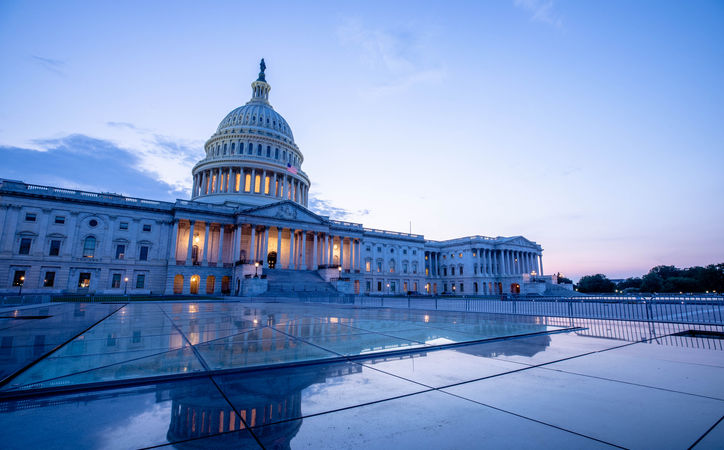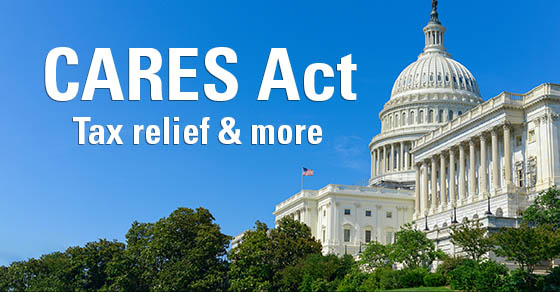To help you communicate important information about the CARES Act to your clients and other contacts during the COVID-19 pandemic, we’re providing a complimentary article, social media post and related image that you can use on your website and social media – or send it out via email. Copy the article below and publish it on your website and then use the suggested social media post and image shown below the article to share it far and wide.
COVID-19 relief: Overview of the CARES Act
The Coronavirus Aid, Relief, and Economic Security (CARES) Act was signed into law on March 27, 2020. In addition to funding the health care fight against the novel coronavirus (COVID-19), the roughly $2 trillion legislation provides much-needed financial relief to individuals, businesses, not-for-profit organizations, and state and local governments during the pandemic. Here are some of the key provisions for individuals and businesses.
Economic Impact Payments
The CARES Act provides one-time direct Economic Impact Payments of up to $1,200 for single filers or heads of households; married couples filing jointly can receive up to $2,400. An additional payment of up to $500 is available for each qualifying child under age 17.
Economic Impact Payments are subject to phaseout thresholds based on adjusted gross income (AGI). The phaseouts begin at $75,000 for singles, $112,500 for heads of household and $150,000 for married couples.
The payments are phased out by $5 for every $100 of AGI above the thresholds. For example, the payment for a married couple with no children is completely phased out when AGI exceeds $198,000. The payment for a head of household with one child is completely phased out when AGI exceeds $146,500. And, for a single filer, it’s completely phased out when AGI exceeds $99,000.
Employee retention credit
The CARES Act creates a new payroll tax credit for employers that pay wages when:
- Their operations are partially or fully suspended because of certain government orders related to the COVID-19 pandemic, or
- Their gross receipts have declined by more than 50% compared to the same quarter in the prior year.
Eligible employers may claim a 50% refundable payroll tax credit on wages paid (including health insurance benefits) of up to $10,000 that are paid or incurred from March 13, 2020, through December 31, 2020.
For employers who had an average number of full-time employees in 2019 of 100 or fewer, all employee wages are eligible, regardless of whether the employee is furloughed. For employers who had a larger average number of full-time employees in 2019, only the wages of employees who are furloughed or face reduced hours as a result of their employers’ closure or reduced gross receipts are eligible for the credit.
Be aware that additional rules and restrictions apply.
Paycheck Protection Program (PPP)
This $349 billion loan program — administered by the Small Business Administration (SBA) — is intended to help U.S. employers keep workers on their payrolls. To potentially qualify, you must have fewer than 500 full- or part-time employees. PPP loans can be as large as $10 million. But most organizations will receive smaller amounts — generally a maximum of 2.5 times their average monthly payroll costs.
If you receive a loan through the program, proceeds may be used only for paying certain expenses, generally:
- Payroll (including benefits),
- Mortgage interest,
- Rent, and
- Utilities.
Perhaps the most reassuring aspect of PPP loans is that they can be forgiven — so long as you follow the rules. And many rules and limits apply. Because of the limited funds available, if you could qualify, you should apply as soon as possible.
The CARES Act expands business access to capital in additional ways. Many of the other loan programs are also being administered by the Small Business Administration (SBA).
Modifications of TCJA provisions
The CARES Act rolls back several revenue-generating provisions of the Tax Cuts and Jobs Act (TCJA). This will help free up cash for some individuals and businesses during the COVID-19 crisis.
The new law temporarily scales back TCJA deduction limitations on:
- Net operating losses (NOLs),
- Business tax losses sustained by individuals,
- Business interest expense, and
- Certain itemized charitable deductions by individuals and charitable deductions for corporations.
The new law also accelerates the recovery of credits for prior-year corporate alternative minimum tax (AMT) liability.
Significant for the hard-hit restaurant and retail sectors, the CARES Act also fixes a TCJA drafting error for real estate qualified improvement property (QIP). Congress originally intended to permanently install a 15-year depreciation period for QIP, making it eligible for first-year bonus depreciation in tax years after the TCJA took effect. Unfortunately, due to a drafting glitch, QIP wasn’t added to the list of property with a 15-year depreciation period — instead, it was left subject to a 39-year depreciation period. The CARES Act retroactively corrects this mistake and allows you to choose between first-year bonus depreciation and 15-year depreciation for QIP expenditures.
Additional provisions under the CARES Act
The financial relief package under the CARES Act also includes provisions to:
- Significantly expand unemployment benefits for workers,
- Allow IRA owners and qualified retirement plan participants under age 59 ½ who suffer certain adverse effects due to the COVID-19 pandemic to withdraw in 2020 up to $100,000 and then recontribute the withdrawn amount within three years with no federal income tax consequences,
- Waive required minimum distributions (RMDs) from IRAs and retirement plans that would otherwise have to be taken in 2020 to avoid an expensive penalty,
- Provide an above-the-line charitable deduction of up to $300, generally for 2020 cash contributions to qualified charities, and
- Exclude from an employee’s taxable income up to $5,250 of employer payments made on the employee’s student loans from the date of the CARES Act’s enactment through December 31, 2020.
- The CARES Act also allows employers to defer their portion of payments of Social Security payroll taxes through the end of 2020 (with similar relief provided to self-employed individuals).
Need help?
Keep in mind that additional guidance could be released — or new legislation could be signed into law — that could affect these CARES Act provisions. And more relief measures may be forthcoming.
The COVID-19 pandemic has affected every household and business in some way. If you have suffered financial losses, contact us to discuss resources that may be available to help you weather this unprecedented storm.
© 2020
How to share this content with your clients
Here are some guidelines for sharing this content:
- Click the image above and save it to your computer. (Note: This image can be used only with the article provided here.)
- Copy and paste the “Full Article” to your website and insert the provided image along with the article.
- To share on social media, copy and paste the short “Social media link post” below to your preferred social site. Include a link back to the article you’ve published on your website at the end of your post.
Tip: Content and image are optimized for use on Facebook and LinkedIn.
Social media link post for you to share
Copy and paste the content below onto your social media platforms with a link to the article you’ve published on your website:
The CARES Act provides roughly $2 trillion of tax and financial relief in response to the coronavirus pandemic. How can it help you?
Don’t forget to include the link back to the article you’ve published on your website.
We are here to help you during this challenging time. Learn more about other content offerings from Checkpoint Marketing for Firms that you can use to communicate with your clients or our Social Media Manager platform.








